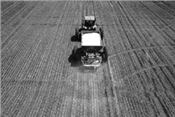Time To Spread Fertilizer–Evenly

DR. PETER C. SCHARF
COLUMBIA, MO.
As I write this on October 6, USDA estimates that 80 percent of Missouri corn and more than 75 percent of Missouri soybeans are in excellent or good condition. This is the best in the past 5 years for both crops.
Harvest is well under way and I hope that most of you are pulling in the good yields that USDA predicted.
For many people, the fertilizer spreaders will be running not far behind the combines. Farmers will be replenishing their fields with P and K to keep productivity levels as high as they can be.
In most fields, P and K will be applied using a spinner spreader. This type of applicator can do a lot of acres quickly and is easier to maintain than an airboom spreader.
The main issue with spinner spreaders is the potential for uneven applications of fertilizer. Over the past few years, we have tested a number of spinner spreaders with catch pans and have found that it's fairly common for the spread pattern to be less than what you'd want. There is no good way to verify that these machines are spreading the pattern that you want except to catch the fertilizer and weigh it. The chart is an example of a problem we found in measuring a spreader pattern (average of 2 tests).
We are running a test program, funded by the Missouri Fertilizer Board, to test the spread pattern of spinner spreaders and verify that they are right, or help people to get them right. If you'd like to have the spread pattern tested for your machine or in your fields, contact me (573-808-5396) or Larry Mueller (573-289-1748) to set up a time. Best to text either of us first to set up a call. ∆
DR. PETER C. SCHARF: Professor Plant Sciences, University of Missouri
